Michael A. Turton
Note: the previous version of this page is here
|
Michael A. Turton |
|
| Driving in Taiwan Note: the previous version of this page is here |
|
| Introduction | Surviving on Taiwanese Streets | Highway Driving | Licenses and Vehicle Ownership | Scams and Safety | Road Navigation |
| Consequently, driving in Taiwan is an inconvenient, stressful, and even dangerous act. |
| The biggest problem in Taiwanese driving is the omnipresence of scooters. They generally ignore traffic laws, safety, and the convenience of other drivers, and if you hit them, they always claim it is your fault regardless of the situation. When you first start driving here, pay close attention to them, because they will not pay attention to you. |
| Hardly a day goes by when I don't see an accident of some kind. Be paranoid, not just careful. | 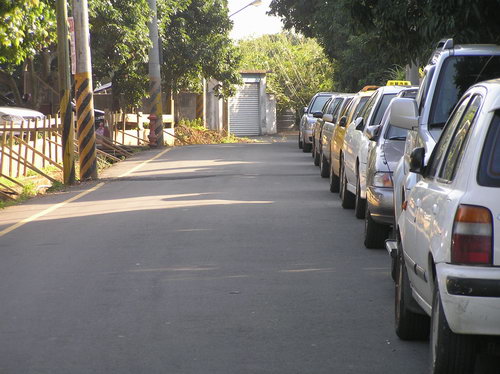 Cars parked on
a mountain road as their owners go hiking. Cars parked on
a mountain road as their owners go hiking. |
| A friend of mine who has been here 14 years
distilled the
basic principle of driving here into a single pithy sentence:
You are responsible for what is in front of you. |
| Introduction | Surviving on Taiwanese Streets | Highway Driving | Licenses and Vehicle Ownership | Scams and Safety | Road Navigation |
| Traffic laws in Taiwan are pretty much the same
as in the
US. The most important difference is that there is no right on red unless
indicated by light or policeman.
However, most scooter drivers pay no attention to this law. |
| Remember to always check both mirrors
when you turn.
Taiwanese will cheerfully pass left turning vehicles on the left, and
right
turning vehicles on the right.
To date two idiots on scooters have hit me on the left as I was making a legal left turn. Both blamed me.
|
| Huge difference in customs: when a car flashes
its lights
at you, it means: "I'm coming through" not "please go first" as in the
States.
The speed limit on all city streets is 50 kph except where otherwise indicated. |
| If you are the first vehicle in line when the light turns
green, do
not enter the intersection rapidly. Frequently the last vehicles
through
as the light changes from yellow to red will attempt to run the red
light.
The accident risk is extremely high for early entrants into the
intersection.
|
| Drive slowly. Accidents are less destructive that way, and you
have
a higher safety margin. The frequency of red lights obviates any
advantage
gained by speeding.
|
| A word of advice: be careful whom you pass and where you park. Don't yell at, honk at or flip off people on the road, especially if they know your car (if you flip off everyone who drives outrageously you'll soon wear your middle finger to the bone). |
| Look here
to read a discussion of this problem on an internet forum:
As I was driving home on Sunday morning some moron cut into the scooter only lane and forced me up onto the sidewalk. I flipped him off. He got out of his car and gave chase to me, he was holding a bat btw. I outran him on my scooter and he proceeded to follow me through Hsin Chuan. I lost him several times but he kept finding me. Now I was at an intersection and he finally caught me. He proceeded to tell me to that he was going to kill me, well that's what I understood. I kept cool because he had a bat. He then struck me in the upper back. A cop showed up and did NOTHING!!! |
An old woman's recyclable collection slows traffic on a side street. |
| Encounters with gangsters and ganster wannabes
are not
uncommon. They drive small late model vehicles with flashing blue
lights
around the license plates and modified mufflers, or large black cars.
Don't
mess with them. If they attempt to mess with you, drive away or stop
and
let them go. Do not confront them.
Foreign skin does not confer immunity to lead pipes, chains, and knives. |
| When making a right turn, remember that you will cross the motorcycle lane that runs along the right side of the road. Check your mirror carefully before you turn, and turn slowly. Scooter drivers will not do anything to attract your attention, and they are easy to overlook. |
| Again, when making a right turn, check both lanes for oncoming traffic, especially if it is crowded. Taiwanese will drive any direction, any time, especially scooters. For example, it is extremely common for a driver to pull out into the oncoming lane and pass a line of cars waiting for a red light and then make an illegal left or right turn. Scooters will drive in either direction on either side of the street. | 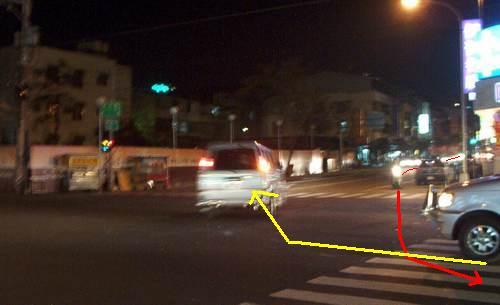 A
common problem: this driver has passed a long line of cars waiting at
the
light by driving up the empty oncoming lane, and is now making an
illegal
right turn by running a red light. Note the scooter on the corner
making
a left turn by pulling into the oncoming lane, shooting across the
front
of the stopped cars, and turning. This dangerous turning method is
ignored
by the police. A
common problem: this driver has passed a long line of cars waiting at
the
light by driving up the empty oncoming lane, and is now making an
illegal
right turn by running a red light. Note the scooter on the corner
making
a left turn by pulling into the oncoming lane, shooting across the
front
of the stopped cars, and turning. This dangerous turning method is
ignored
by the police. |
| Cameras are common both in the cities and small
towns,
and your picture may be snapped anywhere. The government generally
places
signs to warn drivers that cameras are watching them.
|
| When getting out of your car, be sure to check the mirror before opening the door, so you don't kill a passing scooter driver by opening the door in his face. |
| Introduction | Surviving on Taiwanese Streets | Highway Driving | Licenses and Vehicle Ownership | Scams and Safety | Road Navigation |
| The first major highway, known as the Chungshan Highway, or the First Highway, runs closer to the coast. It is three lanes from Taipei until just past Changhua, when it narrows to two (~kilometer marker 211). The speed limit is 100, but you will be lucky to reach that speed Friday through Sunday on the two-lane section. |
| A second major north-south highway, formally Highway 3, but always confusingly referred to as "the second southern highway," opened recently. It follows the coast to Taichung, then swings into the foothills, running parallel to the old one, but usually 10-30 kms from it. The speed limit is 110. |
| The new highway is three gorgeous lanes of empty tarmac through hills all the way, and wonderful rest stops with 7-11s, Starbucks, and other good places. The Taipei-to-Kaohsiung time is 30-45 minutes longer, however. |
| Speed traps are as sophisticated as in any
Western country
and both radar and lasers are used. Look for speed traps within 3 or 4
kilometers either way of a toll booth, and under bridges. Also, police
cars frequently run their flashing lights while operating a speed trap,
so you'll often have warning.
Automatic cameras are also deployed along the highway to catch speeders. They really work, so don't speed. |
|
 A highway on the east coast. |
|
| Currently policy gives you 10 kph on the old highway, but only 3 kph on the new. Thus, you will be ticketed at 111 on the old highway, and 114 on the new. |
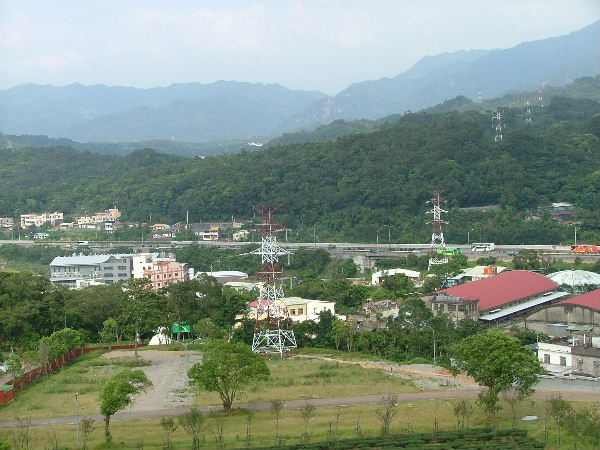 The highway near Sanyi. |
The 350 km drive from
Kaohsiung to Taipei
generally takes
4-5 hours depending on traffic and road destruction......er....
construction. Although major signs are in both English and Chinese, crucial road information such as detours and construction will only be in Chinese. |
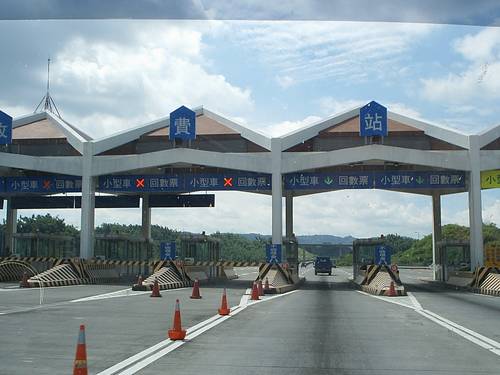 Entering
the tollbooth in Taiwan. The blue lane is for those with toll
tickets;
you can purchase those at most gas stations or at highway rest stops.
The
cash lane is marked in yellow to the right; passenger vehicles are $40.
There are no markings in English, of course. Entering
the tollbooth in Taiwan. The blue lane is for those with toll
tickets;
you can purchase those at most gas stations or at highway rest stops.
The
cash lane is marked in yellow to the right; passenger vehicles are $40.
There are no markings in English, of course. |
Be sure to get in the correct lane at the tollbooths. The yellow lane is for cash, the blue lanes for toll tickets. Entering the wrong lane to pay the toll is an NT$3,000 fine. |
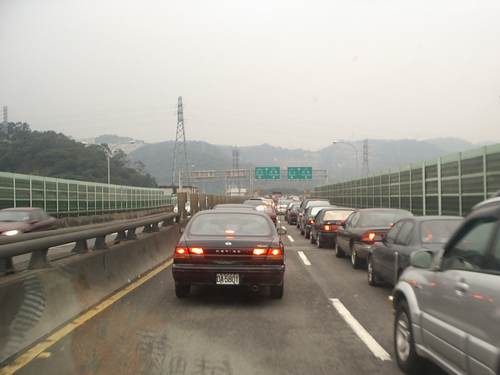 An
entrance ramp in Chungho packed on Chinese New Year, around noon. An
entrance ramp in Chungho packed on Chinese New Year, around noon. |
There are two things to be aware of. First, leave
early.
Highways get crowded after 10:00. Chinese New Year used to be famous
for
traffic jams that literally extended from one end of the island to
another,
and travel times from Kaohsiung to Taipei of 16-30 hours. Although the
new highways have relieved the crowding, still the traffic is
massive.
You can avoid it all by getting out early. |
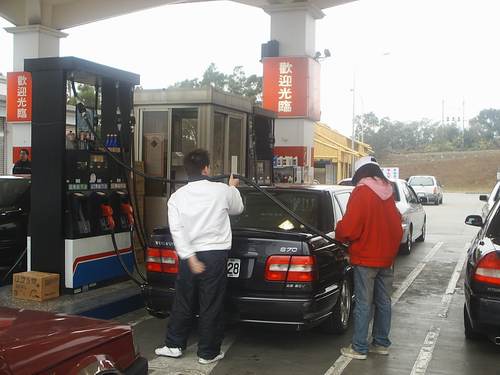 A
service station at a highway rest stop (Kuanhsi).
A
service station at a highway rest stop (Kuanhsi). |
Second, do not drive on the new highway after midnight. In many sections of that highway, drivers in search of Darwin Awards drag race in the wee hours at speeds in excess of 200 kph. There was a spate of accidents a while back, and the police finally started to crack down, but the practice continues in more isolated areas (the Toufen-Miaoli-Chingshui section, for example). |
| Introduction | Surviving on Taiwanese Streets | Highway Driving | Licenses and Vehicle Ownership | Scams and Safety | Road Navigation |
| Quite a few foreigners obtain motorcycles. If
you live outside Taipei, it is difficult to live without a scooter. |
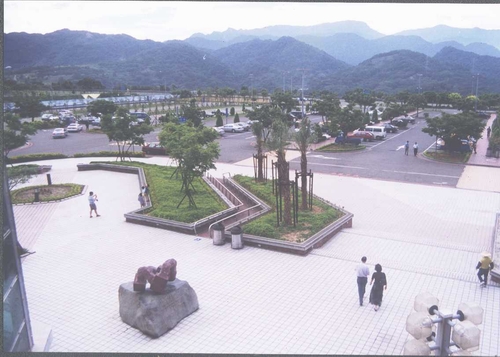 The lovely view from from the rest stop at Kuanhsi in the
mountains
southwest
of Taipei. The lovely view from from the rest stop at Kuanhsi in the
mountains
southwest
of Taipei. |
| A license is required for scooters of different sizes -- 50 CC, 100 CC, 150 CC. Currently an ordinary drivers' license suffices for the 50 CC size. | |
| Many foreigners drive
motorcycles without proper licenses, or any at all, as it is common
knowledge that the police are less likely to hassle foreigners on
scooters, and more likely simply to wave them by. Note that I am not
advocating you drive without a license, I merely observe that it is the
norm among foreigners. |
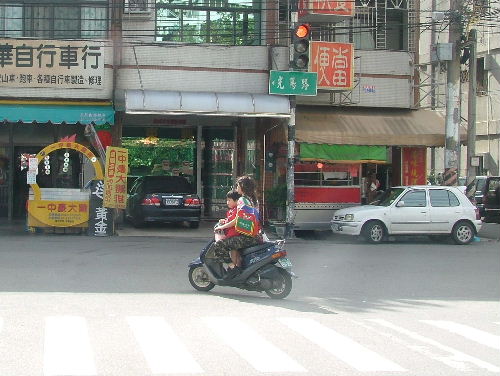 A helmetless woman, with a helmetless son, makes an illegal left turn against a red light. Very common outside of Taipei, where helmet law enforcement is better. |
| Cars may also be purchased, but it is extremely
difficult
to obtain a loan unless you are a local. Car loans must also be
co-signed
by a citizen of Taiwan as well. Better to pay cash, or borrow from
Dad.
Vehicles in Taiwan are competently made, but skimpy on the safety equipment and structure. Rear seatbelts are extras in vans. Car salesman are as trustworthy as anywhere. |
| Currently you must renew your drivers license
each time
you renew your ARC (work visa). Drivers education centers are found
everywhere.
The drivers license situation is idiotic. Most American states do not recognize Taiwanese licenses, so Taiwanese must take a test there. Consquently, most Americans must take the test here There is a written test (impossible to fail) and a road test (impossible to pass). The road test is done in a closed course which is completely unreflective of real-world conditions: it is built so you fail regardless of skill or experience. Nearly everyone fails the first time (this writer included, a most humiliating experience) and most fail more than once.
|
| The reason it is designed this way is simple:
graft. In
the old days the road test facility was also the site where driving
class
takes place. Since the people who teach driving are the same people who
administer the test, they make big bucks when you fail and are then
forced
to register for their classes (welcome to Taiwan: scam island). |
| The majority of people register for driving classes so they can practice with the substandard vehicles provided by the test site on the dreaded "S" curve itself, a tight S-shaped curve which must be backed down in one fluid motion -- you are not allowed to stop or go forward. For those of you who are curious, on my second test (which I passed), my friend's friend's brother's friend, who administered the test, said I drove extremely well. |
| Introduction | Surviving on Taiwanese Streets | Highway Driving | Licenses and Vehicle Ownership | Scams and Safety | Road Navigation |
| My advice is to pay the money and not inform the police. Even in the highly unlikely event that they find the thief, the punishment for auto theft is light, and the thief knows where you live. I did have an enterprising student who managed to persuade the thief she had deposited the money when in fact she hadn't, and got her car back. Later, though, he contacted her and threatened her, and she was forced to sell the car. |
| A man rear-ends you in a
motorcycle,
and then claims it is your fault and demands you pay him a small some
of
money, usually NT$3,000. Violence will be implied or stated. Variation
on this: the vehicle taps you, claims it is your fault, and then tries
to get you to pay for the damage to the goods in his car.
Clever,
eh?
Also, motorcycles will lie in wait, ram a car, and then claim the car was running the red light, with "witnesses" in cahoots. This apparently happened to me once. |
| In another case I know, a foreign motorcyclist was wounded in a fender-bender badly enough to require skin grafts, yet was hunted down at work and money extorted to pay for the car's damaged side mirror. I have been chased once by a taxi driver who hit my bike, and cornered in a cul-de-sac by irate gangsters, wielding a lead pipe, whose car they thought I had honked at. Not fun. |
| I now mount a video camera in the front of the car at all times when driving in the city, and recommend you at least carry one with you at all times. |
| In November of 2002 a moron speeding on a scooter
ran a
red light and nailed the front of my car, leaving me with NT$25,000 in
repairs. In addition to the traffic violations, he was also AWOL from
his
military base. If only I had recorded the whole thing....luckily the
physical
evidence strongly favored my story. It happened in the idiot's
neighborhood
and his chums came to help him. They were ruffians, and filled the
atmosphere
with intimidation and death threats, 90% of it fortunately mere
posturing.
They also followed my wife home. "Witnesses" magically appeared who
said
it was I who had run the red light..
Carry a video camera, or at least a still camera, so you can film the area if you are hit. No one will volunteer to be a witness for you. |
| Parking in areas which someone considers their
own is risky
(avoid parking in front of someone else's house). Many of my Taiwanese
friends have had windows and lights smashed, paint keyed (very common)
and so forth when they accidently did that.
Always ask if you park in front of a house or shop. |
| Taiwanese will also randomly slash or puncture
tires, key
cars left out in the street, and kick dents in new cars (happened to
several
people I know).
In Taiwan, to own a car is to know worry. At least until it is so scratched and dented and abused that nobody would bother to steal it anymore. |
| Never provoke someone in a car -- you just might get beaten. For this reason, never argue with taxi drivers either (see article from China News here). Additionally, NEVER accept anything consumable (food, gum, cigarettes, etc) offered to you in a taxi. You might be drugged and robbed. |
| Another problem is cons on the highway. You'll stop to help an accident victim, and they will either turn out to be crooks who will rob you once you've stopped, or when you get to the hospital, they will accuse you of being the person who hit them and demand payment. It is probably best to avoid stopping at accident scenes, however guilty you may feel about driving past. |
| Of course, not everyone agrees with my opinion. |
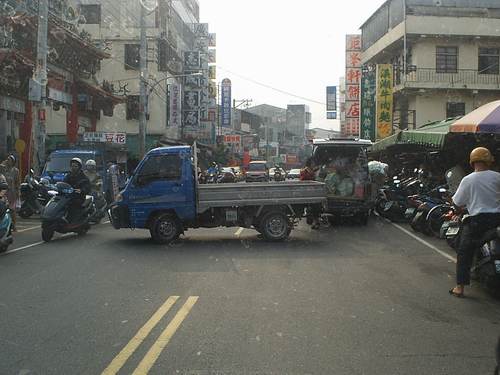 Madness
in front of a morning market as delivery vehicles drop off goods. Avoid
driving past markets in the early morning.
Madness
in front of a morning market as delivery vehicles drop off goods. Avoid
driving past markets in the early morning. |
Getting around is an even bigger pain because locals rarely know the names of roads (they navigate by landmarks), and often do not admit when they don't know. I can't begin to tell you how many times I've had conversations like: |
| TURTON: Can you tell me where the Pacific Swim
World is? LOCAL: Sure! It's up ahead. Just turn right. TURTON: Where? Which road? LOCAL: I don't know the name of the road. My wife's cousin's brother-in-law's house is there. Anyway, just go up ahead, and turn right. There's a morning market there. TURTON: (realizing it's the afternoon) Well, thanks for the help! See ya! |
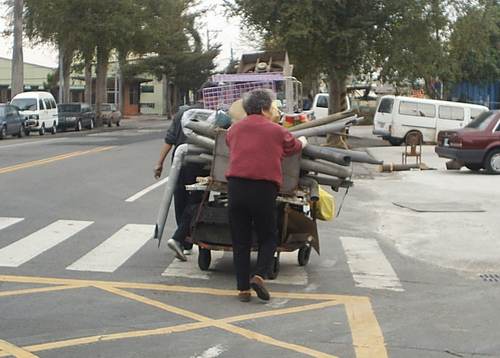 A
common street sight, an old woman pushing her daily catch of
recyclables
to a trash recycling center. A
common street sight, an old woman pushing her daily catch of
recyclables
to a trash recycling center. |
Complicating problems is the fact that Taiwanese often (illegally) remove address signs from in front of their houses as a precaution against theft (if the thief can't find my address, how can he rob my house?) |
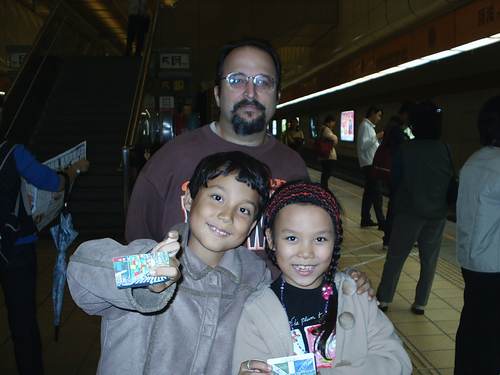 And
if you get lost, just take the metro or hop in a taxi! And
if you get lost, just take the metro or hop in a taxi! |
Fortunately good maps are widely available in both English and Chinese. It is a mystery why; although I have been in taxis and other vehicles hundreds of times, hardly anyone uses them. Most Taiwanese, especially females, are amazed at the cheerful gall of westerners who set out for places armed with nothing more than determination and a good map. |
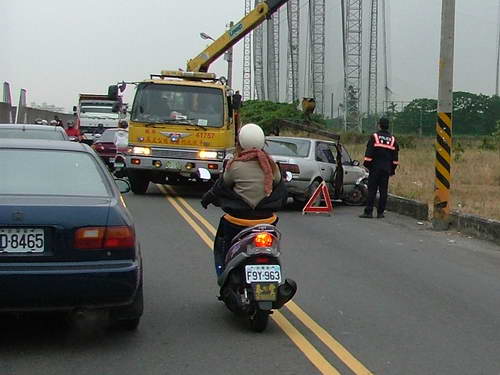 Sorting out an accident on Hanhsi W. Rd in Taiping, my personal choice for the most dangerous road on the island. |
For a more extensive
discussion
and explanation of why things are the way they are on the roads here, see
my blog post on the topic. |
| Introduction | Surviving on Taiwanese Streets | Highway Driving | Licenses and Vehicle Ownership | Scams and Safety | Road Navigation |